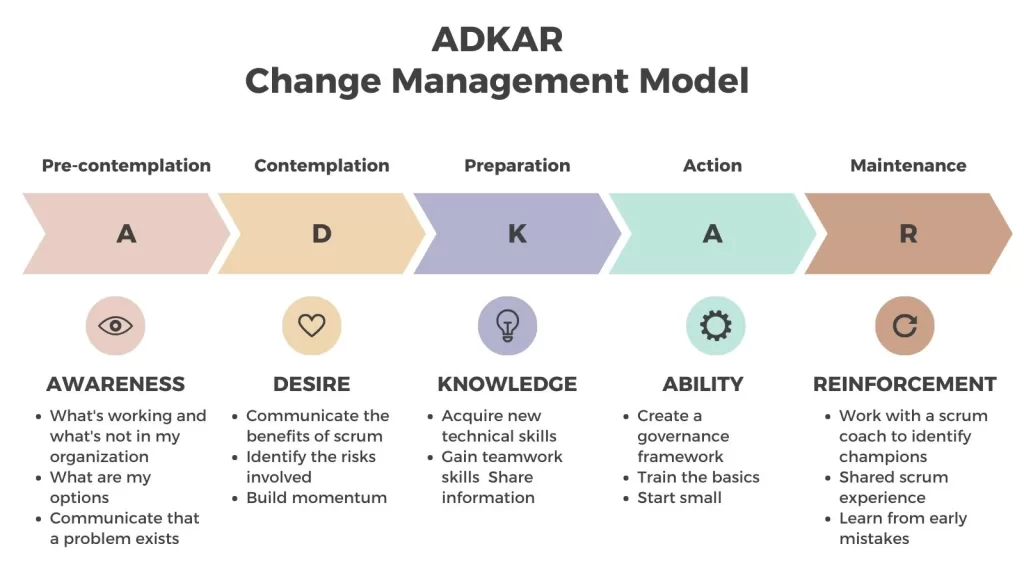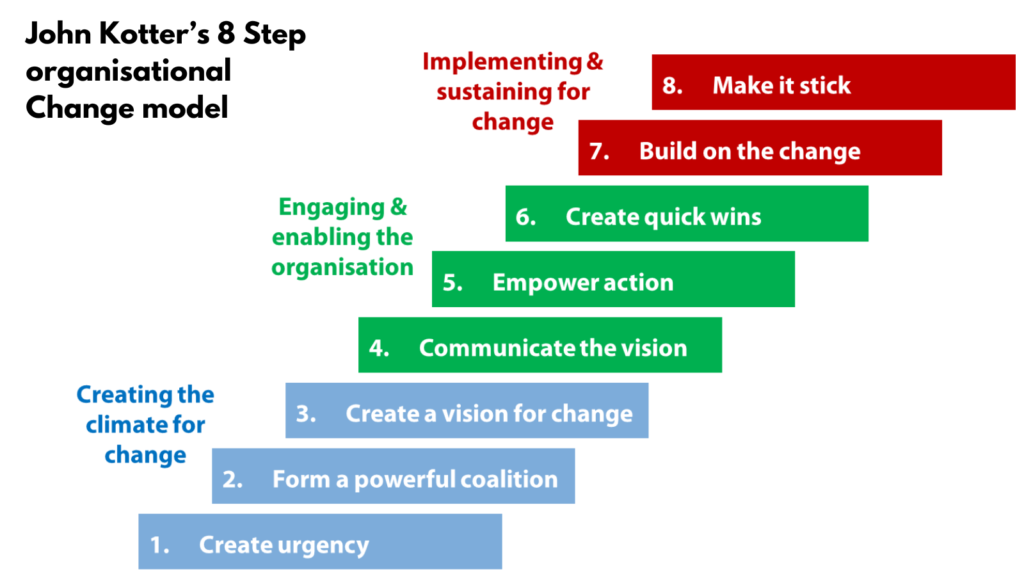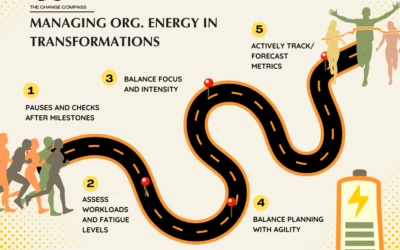On Google,, the 2nd most searched term in change management is ‘change management process’. Users are keen to understand a standard formula that they can apply to manage any change. Most users are looking for something simple, and clear, and lay out a step-by-step process that describes what they need to do to manage change.
Managing change is no longer the arena for change practitioners. The field of change management has grown in such leaps and bounds in the past 20 years that most leadership concepts now have a section on change management. Nearly all large 1st and 2nd tier consulting firms have a change management practice, even the likes of McKinsey, BCG,, and Bain.
Around us, we frequently see change management being mentioned. Change is even a visible tagline for the marketing campaign for lots of organizations. Accenture’s marketing tagline in 2021 is “Let there be change”. The Motto for The University of Technology Sydney is “Think. Change. Do”.
What are the common change management processes?
Prosci is one of the most known change processes, especially for those located in the United States. Change First has a ‘PCI’ (People-Centered Implementation) model. Then there is John Kotter’s 8 steps for leading change. What all the models have in common is the initial engagement and planning, followed by change implementation, ending with a transition and sustaining phase.
Companies like having one change process to follow.
Most organizations with a change management practice will have, as part of their offering, one change management process for all practitioners/managers to follow.
Why is that?
- A common language to talk about managing change so that different stakeholders can refer to the same language, especially those who are not changing practitioners. Creating terms that are easily understood by stakeholders within the company makes sense.
- Ensure new change contractors adhere to “the way of doing things” in managing change within the organization. This is often a big complaint, that a new contractor will bring with him/her new ways of doing things, many of which may not gel well within the particular organization.
- Create a minimum level of expected quality in managing change so that at least the ‘minimum’ is carried out and that there isn’t anything obvious that is left out. This is especially important for project teams who may not know what change managers do and what outputs they should be working on.

Prosci’s ADKAR model, a framework focusing on five key elements—Awareness, Desire, Knowledge, Ability, and Reinforcement—that individuals need to successfully navigate change.

John Kotter’s 8 steps model for leading change, providing a roadmap for organizations to effectively manage change, from creating a sense of urgency to anchoring changes in the company culture.
So what is wrong with using a change management process?
Not one change process may be relevant for all cases Change management processes and concepts are good as general references to guide the change practitioner in baselining and learning the key steps that are critical in establishing a good change outcome. No change management process can suit every company and every type of change. This is why it is a good idea to leverage a diverse range of change processes for change managers who are starting out in the industry. Different change processes may cover different areas, therefore provide a synergistic range of references.
For example, John Kotter’s 8 steps of leading change are great for all levels of leaders and team managers as the model is focused on managers leading groups of people through change. On the other hand, Prosci’s ADKAR model is more suitable for a project context where there are a series of activities over several project phases to lead impacted stakeholders through the change.
Also, some change processes may not be applicable for all change scenarios. For example, the famous ‘change curve’ or the Kubler-Ross model of grief and loss. For some reason, this model has been applied so much within a change context that a lot of business people expect that the ‘change curve’ will always occur.
This is absolutely false. In the change curve, there is a prescribed process of shock, denial, frustration, and depression. There are not many change scenarios in which large groups of people go through these emotions. Examples include large-scale restructuring involving retrenchments. However, for standard process changes, technology upgrades, or new product launches, it is very rare that you will see this process being applicable at all.
Blindly following the process One of the biggest dangers and risks of following a change process is not to know when to deviate from the process. This may especially be the case for less experienced change practitioners. The outcome of blindly following the process can mean that the change actually does not happen and the change dial is not moved at the end.
What I often see from change managers who blindly follow the process is a change plan that contains a series of generic activities such as stakeholder engagement, communication, and then launch. Often in these cases, there isn’t a deep understanding of what the change involves from the perspectives of impacted employees. What it means to them may be more than just meeting informational needs. There could be subconscious attachments or preferences/habits that are hard to break.
An analysis of the perceptions and history of changes experienced by those impacted by change is critical. What you may uncover is potential anxieties, expectations, habits, and misunderstanding of what the change involves. This may be ignored by popular change processes.
Change processes may not be linear Experienced change practitioners have seen this. Often what is planned on paper does not actually pan out to be the case. Most change processes follow a scenario where everything goes well. But for complex changes, there are often mishaps or obstacles.
For example:
- Key stakeholder groups were not identified upfront and the delay in engaging with them causes overall project delays and stakeholder complications.
- Feedback from stakeholders is that the initial messaging was not clear enough and did not reach all groups. Another round of communications and engagement campaign is required to reset expectations.
- Learning content was too long and did not sufficiently match employee expectations, thereby resulting in lower completion rates.
- After the project rollout, as soon as resources were pulled out of the project team after go-live, adoption rates dived, resulting in little benefits achieved.
In many of these cases described above, the change practitioner needs to repeat certain processes, go back to previous steps, or even split stakeholders with some progressing further in the change process than others.
Following a process may inhibit experimentation One of the core aspects of agile ways of working in implementing change is experimentation. We see teams from development and marketing constantly experiment and learn to evolve into a solution that meets business objectives. In change management, there is little practice in experimentation, even though this is such a core part of agile.
Blindly following the process
One of the reasons could be that change practitioners are used to following a prescribed change process and not used to experimenting with their change approach. Instead, most rely on previous experience or what others have done in other change initiatives. Despite this, there are many good reasons for experimenting change approaches, especially for large/complex change initiatives.
Potential experiments can include:
- Communication positioning
- Leader storyline for the rationale of the change
- Training content
- Change measurement
- Impact assessment design
- Townhall design
- Behavior reinforcement and incentives
Not sufficiently emphasizing the importance of measurement Measurement is one of the most important aspects of managing change. Without knowing exactly the outcome of each of the activities we are executing how do we know that we are in the right trajectory? Also, measuring our change intervention ensures that we have the exact gauge on how effective the interventions are, and also where the stakeholders are along the journey. If we’ve not had any complaints or ‘noise’ does not mean that all is well and that the change will take place.
How are you measuring your changes so that you understand where your stakeholders are transitioning to?
Future Trends: Discuss emerging trends and innovations in the field of change management, such as the integration of artificial intelligence, agile methodologies, or digital transformation initiatives. Providing insights into future directions can help readers stay ahead of the curve and adapt their change management strategies accordingly.
In addition to established methodologies, the future of change management is being shaped by cutting-edge technologies and innovative approaches that are revolutionizing how organizations navigate transitions. One of the most exciting developments is the integration of artificial intelligence (AI) into change management processes. AI-powered analytics can provide deep insights into organizational dynamics, predicting potential challenges and offering personalized interventions to drive successful change outcomes.
Furthermore, the rise of agile methodologies is transforming traditional change management practices. Agile principles emphasize adaptability, collaboration, and iterative progress, enabling organizations to respond rapidly to evolving market conditions and stakeholder needs. By embracing agile frameworks, change leaders can foster a culture of continuous improvement and empower teams to embrace change as a catalyst for innovation.
Moreover, digital transformation initiatives are reshaping the landscape of change management. As businesses undergo digital transformations to stay competitive in today’s rapidly evolving digital economy, change management becomes increasingly intertwined with technology adoption and organizational agility. Leaders must navigate complex ecosystems of interconnected systems, processes, and stakeholders, leveraging digital tools and platforms to drive seamless transitions and sustainable change.
Incorporating these emerging trends into their change management strategies, organizations can position themselves at the forefront of innovation, driving successful transformations that propel them toward future growth and success.
To read more about measuring change visit The Ultimate Guide to Measuring Change.






